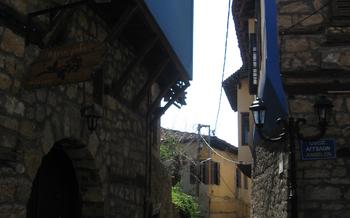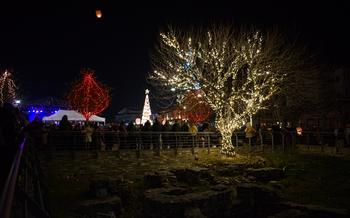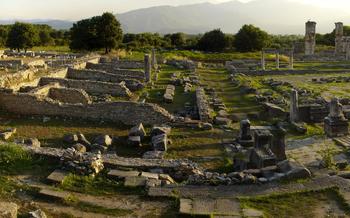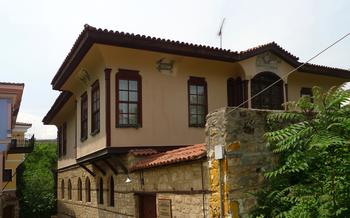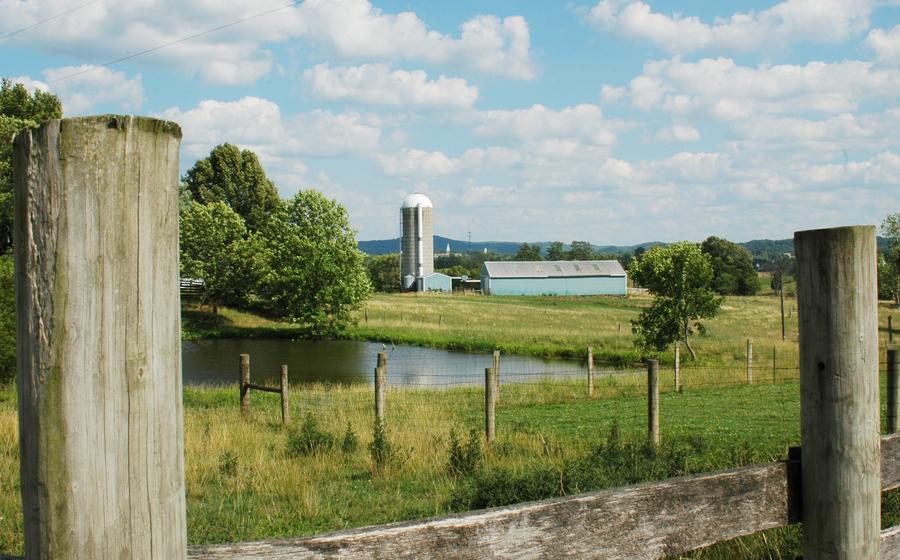
The Catacombs of Saint Paul
- The Catacombs of Saint Paul: A Journey Through History
- The Discovery of the Catacombs: Unveiling a Hidden Treasure
- Exploring the Catacombs: A Walk Through Time
- The Frescoes and Symbolism: A Visual Narrative
- Pilgrimage and Faith: A Sacred Destination
- Guided Tours: Unveiling the Secrets of the Catacombs
- Practical Information for Visitors: Planning Your Trip
- A Glimpse into Early Christian Life: Unveiling Ancient Practices
- The Catacombs and the Holocaust: A Poignant Connection
- Cultural Heritage and Preservation: Protecting a Precious Legacy
- Nearby Attractions and Must-Sees: Exploring Veria's Treasures
- Shopping and Souvenirs: Taking a Piece of Veria Home
- Insider Tip: A Serene Escape in Nature
The Catacombs of Saint Paul: A Journey Through History
Step into the depths of time and explore the Catacombs of Saint Paul, an evocative testament to the early Christian presence in Veria. These subterranean chambers, dating back to the 4th century AD, offer a glimpse into the lives and beliefs of the faithful during a time of persecution. Descend into the underground labyrinth and discover a hidden world of faith, resilience, and eternal hope.
Veria holds a special place in the history of Christianity, as it was one of the cities visited by the apostle Paul during his second missionary journey. His presence left an indelible mark on the city, and the catacombs are a tangible reminder of his influence. Located in the heart of Veria, these sacred chambers are easily accessible, inviting visitors to embark on a journey through the annals of Christian history.
The Discovery of the Catacombs: Unveiling a Hidden Treasure
The unveiling of the Catacombs of Saint Paul in Veria was a groundbreaking moment that shed light on a hidden chapter of early Christianity. In 1959, during construction work near the city center, workers stumbled upon the entrance to an underground complex. Excavations commenced, revealing a labyrinthine network of tunnels, chambers, and burial niches that had remained concealed for centuries.
The archaeological significance of this discovery was immense. The catacombs provided tangible evidence of an organized Christian community in Veria dating back to the 4th century AD. The well-preserved frescoes, inscriptions, and architectural features offered valuable insights into the beliefs, practices, and daily lives of early Christians in the region.
The discovery of the catacombs sparked a wave of interest in the history of Christianity in Veria. It prompted further archaeological research, leading to the uncovering of additional catacombs and early Christian churches in the city. These discoveries have contributed significantly to our understanding of the development and spread of Christianity in this part of the world.
Exploring the Catacombs: A Walk Through Time
Descending into the Catacombs of Saint Paul is like stepping back in time, immersing yourself in a subterranean world that holds secrets of a bygone era. The catacombs are an intricate network of underground tunnels, chambers, and niches carved into the soft rock beneath the city of Veria. These ancient passageways once served as a place of refuge, worship, and burial for early Christians during times of persecution.
The catacombs are characterized by their unique architectural features. The walls are lined with rows of arcosolia, arched niches that were used to house the dead. These arcosolia are often adorned with intricate carvings and frescoes, providing a glimpse into the artistic traditions of early Christianity. The ceilings are supported by columns and arches, creating a sense of grandeur and solemnity within the underground chambers.
The atmosphere within the catacombs is palpable, a mix of awe and reverence. The air is cool and damp, and the only sounds are the echo of your footsteps and the occasional drip of water. As you wander through the tunnels, you can almost feel the presence of those who once sought refuge here, their stories etched into the walls and floors.
The Frescoes and Symbolism: A Visual Narrative
The interior walls of the Catacombs of Saint Paul are adorned with a remarkable collection of frescoes, providing a visual narrative that enhances the historical and religious significance of the site. These frescoes, created in the Byzantine style, depict a range of biblical scenes, symbolic motifs, and allegorical representations, offering insights into the beliefs and practices of early Christians.
One of the most notable frescoes portrays the scene of Saint Paul preaching to the people of Veria. In this depiction, Saint Paul is depicted as a majestic figure, surrounded by attentive listeners, emphasizing his role as a prominent missionary and spreader of the Christian faith. Other frescoes depict scenes from the Old and New Testaments, such as the creation of Adam and Eve, the Annunciation, and the Crucifixion, providing a comprehensive narrative of the Christian story.
The symbolism employed in the frescoes is particularly intriguing. Many of the images carry deeper meanings, representing abstract concepts or theological ideas. For example, the image of a dove often symbolizes the Holy Spirit, while the depiction of a fish represents Jesus Christ. These symbolic elements add layers of meaning to the frescoes, inviting visitors to contemplate and interpret their significance.
The frescoes in the Catacombs of Saint Paul are not merely decorative elements; they serve as powerful tools for conveying religious messages and teachings. Through their vibrant colors and expressive forms, these frescoes bring the stories and symbols of Christianity to life, immersing visitors in a world of faith and devotion.
Pilgrimage and Faith: A Sacred Destination
The Catacombs of Saint Paul hold profound significance as a pilgrimage site, attracting devout Christians and visitors seeking spiritual enlightenment. For believers, it is an opportunity to trace the footsteps of Saint Paul, whose teachings and ministry left an enduring impact on Veria. The catacombs offer a tangible connection to the early Christian community, allowing pilgrims to immerse themselves in the history and faith that shaped this region.
Participating in religious practices and traditions within the catacombs provides a unique and deeply personal experience. Visitors can light candles in remembrance of Saint Paul and pray in the serene and hallowed atmosphere of the underground chambers. The catacombs serve as a place of reflection, meditation, and spiritual renewal for those seeking a deeper connection with their faith.
Guided Tours: Unveiling the Secrets of the Catacombs
To fully appreciate the historical significance and intricate details of the Catacombs of Saint Paul, guided tours are available to enhance your visit. Knowledgeable guides offer a wealth of information, bringing the past to life as they lead you through the underground tunnels and chambers. With their expertise, they unveil the stories behind the frescoes, explain the symbolism, and provide insights into the lives of the early Christians who sought refuge and worshiped within these sacred walls.
Whether you're a history buff, a religious pilgrim, or simply curious about early Christian life, a guided tour will elevate your experience. These tours are conducted regularly, allowing you to choose a time that suits your schedule. Embrace the opportunity to delve deeper into the catacombs' secrets and gain a profound understanding of their cultural and religious significance.
Practical Information for Visitors: Planning Your Trip
Before embarking on your journey to the Catacombs of Saint Paul, it's essential to plan your visit to ensure a smooth and enriching experience. The catacombs are generally open to the public during specific hours, which may vary depending on the season or special events. It's advisable to check the official website or contact local tourism offices for the most up-to-date information on operating hours and any potential closures.
Admission fees are typically charged for entry to the catacombs, contributing to the preservation and maintenance of this historical site. These fees are usually nominal and help support ongoing conservation efforts. Visitors are encouraged to respect the sanctity of the site and follow any guidelines or regulations established for the protection of the catacombs.
To enhance your understanding of the catacombs' history, art, and religious significance, guided tours are highly recommended. Knowledgeable guides can provide insightful commentary and anecdotes, bringing the past to life and helping you grasp the significance of this sacred place. Guided tours are often available in multiple languages, catering to the diverse backgrounds of visitors from around the world.
When planning your visit, consider allocating sufficient time to explore the catacombs at a leisurely pace. Allow yourself to soak in the atmosphere, admire the frescoes, and reflect on the stories and events that have unfolded within these ancient tunnels. Photography is permitted within the catacombs, enabling you to capture memories of your visit and share them with others.
To reach the catacombs, various transportation options are available depending on your location. Public transportation, such as buses or taxis, can be a convenient and affordable way to get to the site. If you prefer the flexibility of exploring at your own pace, consider renting a car to navigate the city and its surroundings. Ample parking is usually available near the catacombs, making it easy to park your vehicle and start your journey into history.
A Glimpse into Early Christian Life: Unveiling Ancient Practices
The Catacombs of Saint Paul offer a unique opportunity to glimpse into the daily lives of early Christians. These underground chambers served as places of worship, refuge, and burial for the first followers of Jesus. By exploring the catacombs, we can gain insights into their beliefs, traditions, and the challenges they faced.
The catacombs were not merely burial sites but also vibrant communities where early Christians gathered for religious ceremonies, fellowship, and mutual support. They were often decorated with frescoes depicting biblical scenes and symbols, providing visual representations of their faith and beliefs.
One of the most remarkable aspects of the catacombs is the evidence they provide of the persecution faced by early Christians. The hidden nature of the catacombs suggests that they were used as a safe haven to escape persecution and celebrate their faith in secrecy. The presence of simple, unmarked graves indicates the humble and often dangerous lives led by these early believers.
The Catacombs and the Holocaust: A Poignant Connection
The Catacombs of Saint Paul hold a poignant connection to one of the darkest chapters in human history: the Holocaust. During World War II, when the horrors of the Holocaust swept across Europe, the catacombs provided a temporary sanctuary for Jews and other persecuted individuals seeking refuge from the Nazis. The underground labyrinth offered a hiding place for those fleeing persecution, serving as a symbol of hope and resilience amidst unimaginable suffering. Stories of survival and courage emerged from the catacombs, where individuals risked their lives to protect and shelter others. The catacombs' role as a refuge during this tumultuous period adds a profound layer of historical significance to this ancient site, reminding us of the indomitable spirit of those who sought solace and protection within its walls.
Cultural Heritage and Preservation: Protecting a Precious Legacy
The Catacombs of Saint Paul hold immense cultural and historical significance, earning their designation as a UNESCO World Heritage Site. Recognizing their exceptional value, UNESCO has taken an active role in preserving and safeguarding this precious site. Restoration efforts and conservation projects have been meticulously undertaken to ensure the catacombs remain intact for future generations. These initiatives demonstrate the global importance of preserving cultural heritage sites and safeguarding the legacy they embody. By protecting the catacombs, we honor the memory of early Christians and ensure their stories continue to inspire and educate generations to come.
Nearby Attractions and Must-Sees: Exploring Veria's Treasures
While delving into the history and significance of the Catacombs of Saint Paul, make sure to allocate time to explore Veria's other captivating attractions. The city boasts a wealth of cultural and historical landmarks that complement your visit to the catacombs.
Stroll along the picturesque streets of the Old Town, where charming architecture and traditional shops line the cobblestone paths. Visit the Archaeological Museum of Veria to discover artifacts and exhibits that shed light on the city's ancient past. Don't miss the Byzantine churches, such as the Church of the Holy Apostles or the Church of the Transfiguration of Christ, which showcase exquisite Byzantine art and architecture.
For a serene retreat, seek out the lush greenery of the city's parks, such as the Municipal Park or the Park of Saint George. These tranquil oases offer respite from the urban bustle and provide opportunities to connect with nature.
Plan a visit to the nearby Vergina, home to the ancient Macedonian capital of Aigai. Explore the impressive archaeological site, including the Royal Tombs of Vergina, where you can marvel at the breathtaking artistry and opulence of the Macedonian kings.
By incorporating these additional attractions into your itinerary, you'll gain a comprehensive understanding of Veria's rich history and cultural heritage, creating a truly memorable and fulfilling travel experience.
Shopping and Souvenirs: Taking a Piece of Veria Home
Veria offers a vibrant shopping scene with a mix of traditional and contemporary stores. As you stroll through the city streets, keep an eye out for unique souvenirs and local crafts that reflect the rich history and culture of the region.
One of the best places to start your shopping journey is the Central Market. This bustling marketplace is a treasure trove of local produce, handmade items, and traditional souvenirs. Here, you can find everything from fresh fruits and vegetables to handwoven rugs, pottery, and intricate jewelry.
For those seeking authentic and unique souvenirs, head to the Old Town. This picturesque neighborhood is lined with charming boutiques and specialty shops that showcase the work of local artisans. You can find handmade leather goods, traditional Greek clothing, and exquisite ceramics that make for perfect mementos of your trip.
Don't miss the opportunity to indulge in Veria's famous street food. Sample the delicious "loukoumades," bite-sized doughnuts drizzled with honey and cinnamon, or try the savory "bougatsa," a flaky pastry filled with cheese or minced meat.
As you shop, remember that your purchases not only bring a piece of Veria home but also support the local economy and traditional crafts. Engage with the friendly shopkeepers, learn about the history behind their products, and take pride in knowing that you're contributing to the preservation of Veria's cultural heritage.
When in Veria, embrace the opportunity to immerse yourself in the local shopping culture, discover unique souvenirs, and savor the flavors of traditional Greek cuisine. Your shopping experience will be a delightful journey that adds a special touch to your visit to this captivating city.
Insider Tip: A Serene Escape in Nature
While exploring the rich history and cultural heritage of Veria, take a break to immerse yourself in the tranquility of nature. Just a short distance from the catacombs, you'll find hidden gems that offer a refreshing escape and a chance to connect with the beauty of the surroundings.
One such place is the picturesque Veria Park, a green oasis located on the banks of the Tripotamos River. Stroll along the meandering paths, admire the colorful flowerbeds, and let the gentle sound of the water soothe your senses. Take a moment to relax on a bench under the shade of ancient trees and savor the peaceful atmosphere.
For those seeking a more active experience, the scenic hiking trails that wind through the surrounding hills offer breathtaking views of the city and the countryside. Lace up your hiking boots and embark on a journey through lush forests, past babbling brooks, and over rolling hills. As you ascend, you'll be rewarded with panoramic vistas that stretch for miles, making your effort worthwhile.
Whether you prefer a leisurely stroll in the park or an invigorating hike in the hills, these hidden gems near the catacombs provide an opportunity to escape the hustle and bustle of city life and reconnect with the tranquility of nature. Embrace the serenity and let the beauty of the surroundings rejuvenate your mind, body, and soul.

